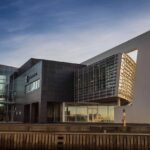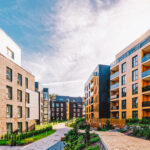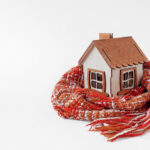The ventilated façade is the most effective construction system available for cladding buildings nowadays. A solution that slots in perfectly with sustainable architectural trends. Before taking a detailed look at the advantages of the ventilated façade, it is worth pointing out that the ventilated façade system consists of a load-bearing wall, an insulation layer and cladding material that is attached to the building with a load-bearing structure. Thanks to this structure, a non-stagnant air chamber is created between the load-bearing wall and the cladding material that allows for ventilation. Generally, there is an insulation layer between the load-bearing wall and the cladding, but this is not always the case, because the load-bearing wall itself can be insulated or the insulating material can be inside the home. The role of the support wall is to guarantee the building’s stability. This wall needs to be sufficiently stable in order to support the weight of the cladding and stress it is subjected to. This supporting wall can be built in brick, cement or wood, among other materials. The most important thing is to perform a calculation to guarantee that the load-bearing wall supports the weight of the cladding material per m2 and, above all, that the wall supports the ventilated façade against the calculated wind loads (that is, including the safety coefficients). The air chamber has an opening in the upper wall and another one in the lower part which, together with the micro-ventilation given by the open spaces, allow for a steady circulation of air. The upper opening needs to be adequately protected to prevent water seeping in, as water would reduce the effectiveness of the insulation. Lastly, as far as the insulation layer is concerned, the insulation can be done either inside or outside the house, but we would recommend installation outside of the load-bearing wall, in order to guarantee better thermal performance and reduce condensation inside the houses.
In light of what has been described, it is fairly easy to imagine there are a large number of advantages to the ventilated façade. Let’s take a look at the main ones now.
Ventilated façade: advantages in terms of thermal and acoustic insulation.
The first significant advantage of ventilated façades – is the one of greatest interest to the user – saving energy A saving of up to 40% can be made with ventilated façades, thanks to the thermal insulation it provides. Good thermal insulation and energy saving are closely linked to the fact that, thanks to these façades, the environment is more actively protected. In this sense, the current contribution of buildings in saving/preserving the ozone layer – due to the reduction in the energy needed to heat and cool them – is prevalent.
Further advantages of ventilated façades include the fact that they are more modern and innovative and have a low maintenance cost. A ventilated façade does not require as many inspections as a conventional one. Furthermore, it also has a much higher-performance guarantee.
The advantages of ventilated façades don’t end here. This construction system has a positive impact on:
- External noise: the ventilated façades are an important barrier to noise;
- Cleaning: they are easy to clean;
- Imperfections: they correct imperfections on the former façades;
- Health: improves the health of the building.
And furthermore, the ventilated façade brings advantages in terms of external insulation that is kept dry thanks to the constant ventilation inside the air chamber. Furthermore, the life of the façade is prolonged if a hard, resistant material like porcelain stoneware is chosen.
Lastly, another of the many advantages of the ventilated façade is that it can reduce structural movements: the air chamber and external insulation allow for a more stable temperature to be maintained in the building’s cladding. This helps prevent the appearance of cracks and openings due to expanding and contracting movements.
Finally, the advantages of ventilated façades can be summed up in a single statement: the ventilated façade is a highly advantageous solution both from a financial and energy saving point of view. It is a commitment for the future and sustainability which, at the same time brings with it a considerable reduction in heating bills and increased heat comfort in the home.
Ecological porcelain stoneware: cladding the ventilated façade with this material is good for the environment.
Why are we talking about ecological porcelain stoneware and claiming that it is good for the environment? Because natural porcelain stoneware is a particularly compact ceramic, achieved thanks to the mix of different natural raw materials – ceramic clay, feldspars, kaolin and sand – that are finely ground until they become a fine granule powder that is then pressed to compact it without the use of glue and which is then baked at extremely high temperatures between 1150-1250 °C – for 25-40 minutes. Imola Tecnica believes that the design of ventilated façades cannot ignore environmental protection and this is why it offers cladding in natural porcelain stoneware inspired by a green philosophy, in full respect of the environment.
We would like to offer our customers products that are both attractive as well as being as ecological as possible: when they are, both or pockets and the well being of the Earth rejoice. Natural porcelain stoneware is ecological for a number of reasons:
- Firstly, it lasts much longer: our eco porcelain stoneware ventilated façades can last a lifetime and still be unchanged. The longer a product lasts, the more it is sustainable, because it avoids having to be replaced. Rather than “planned obsolescence” – that is, the strategy aimed at defining a product’s life cycle in order to restrict its duration to a set period – with natural porcelain stoneware, we achieve the exact opposite: it is “designed” to last;
- Secondly, the natural porcelain stoneware is highly resistant: it is not affected by the sun’s rays or by contact with water, fire or sudden changes in temperature. It is one of the most resistant building materials in the world. This contributes to its prolonged duration and associated benefits that we have just outlined above.
- Furthermore, the natural porcelain stoneware is non-toxic, fire resistant, vapid and inert: it reduces the risk of fires and, as a result, the emission of toxic substances. The fact that it is an inert material ensures that it does not release any kind of atmospheric contamination;
- Lastly, the ecological porcelain stoneware is a material that requires very little maintenance throughout the course of its life: all it requires is the bare minimum to maintain it. In addition, there is no need to use aggressive, corrosive or toxic substances when cleaning it which leads to a limited environmental impact.



